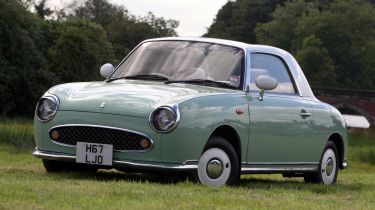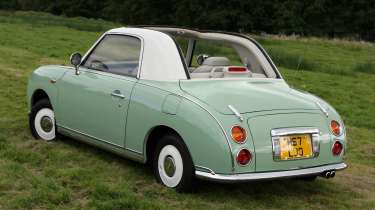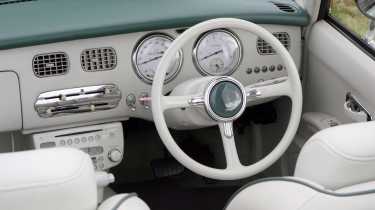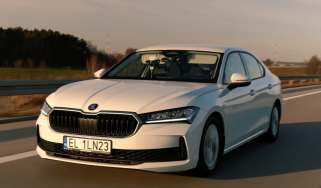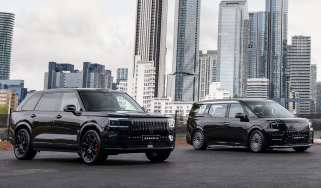Used Nissan Figaro (1991-1992) buyer's guide: the ultimate stylish import
A full used buyer's guide on the Nissan Figaro that was originally on sale between 1991 and 1992
Verdict
You either love or hate the Nissan Figaro. If you’re in the former camp and have now decided that you must have one, your first port of call is to join the owners’ club (figaroownersclub.com), which runs an online classifieds site for its members (figarotrader.co.uk). To put the Figaro’s popularity in the UK into context, at one point there were more than 5,000 of them here, or a quarter of the cars produced, all personally imported. Some of those have since been exported, but there are still plenty to go round. With stable values, a great club scene and low running costs, the Figaro makes a lot of sense – but you must go into ownership with your eyes open.
It's hard to get excited by a Nissan Micra, but reclothe this rather mundane supermini as a retro urban runabout and you can create a level of hysteria usually reserved for cars powered by something rather more exciting than a turbocharged 1.0-litre four-cylinder petrol engine.
Indeed, the Figaro was so popular when it was revealed that Nissan had to run a lottery to choose who would be able to buy the car. The initial plan was to produce 8,000 examples, but by the time production was wound
up, no fewer than 20,056 had been built – with more than five times this many people having entered the ballot to buy one.
Used - available now

2023 Porsche
Cayenne Coupe
42,823 milesAutomaticPetrol3.0L
Cash £44,000
2023 Jaguar
F-Pace
33,515 milesAutomaticPetrol2.0L
Cash £34,990
2023 Land Rover
Range Rover Velar
46,197 milesAutomaticPetrol2.0L
Cash £30,500
2021 Ford
Fiesta
12,659 milesManualPetrol1.0L
Cash £15,027The car was created exclusively for the Japanese market, but it wasn’t long before examples of the Figaro were being imported to the UK, with the model becoming as popular here as in its home market. More than 30 years after the last Figaro was made, this cute-looking retro car has become a cult classic, and as a result it’s well served by specialists as well as clubs.
History
Nissan unveiled the Figaro at the 1989 Tokyo Motor Show under the slogan ‘Back to the future’. It would be another two years before the model – the work of a Nissan special projects group called Pike Factory – went into production, and the cars were released in three batches between February and June 1991. The Figaro was one of four different retro ‘Pike Cars’ released by Nissan; the other three were the Pao, Be-1 and S-Cargo.
Did you know you can sell your car through Auto Express? We’ll help you get a great price and find a great deal on a new car, too.
On the road
There's nothing about the Figaro’s driving experience that will thrill you, but it’s perfectly competent in general. With just 75bhp on tap, plus 106Nm of torque, the Figaro isn’t an accomplished motorway cruiser, but around town and on A and B-roads it’s fine. The turbocharged 987cc engine provides swift enough progress at lower speeds.
The three-speed automatic gearbox seems dated in a world of eight-speed transmissions, while the power steering feels vague and the ride is so-so. But none of these things seem to bother Figaro owners at all.
Which one should I buy?
There isn’t much to separate one Figaro from another, apart from condition and bodywork colour. Four paint hues were offered, each representing one of the four seasons. Buyers could choose between Topaz Mist, which is the rarest with just 2,279 made, Emerald Green (5,632 built), Pale Aqua (3,989) and Lapis Grey (8,156).
With all Figaros getting leather trim, a fold-back cloth roof, air-con and a three-speed automatic gearbox, there wasn’t much scope for the firm to offer extras. The Figaro didn’t wear Nissan badges and there was no powered option for the opening roof mechanism, but the company offered 55 accessories, many of which are now very sought after; they’re listed in detail on the Figaro Owners’ Club. These include chrome add-ons, mud flaps, a CD player, various bits of luggage and floor mats.
A really cherished Figaro will come with a full complement of supplied accessories, such as the original space-saver spare wheel and the associated jack, a tonneau cover and a tool kit. You might even manage to find an example with the original red breakdown flare, which is clipped to the left-hand side of the passenger footwell.
Alternatives to the Nissan Figaro
There's nothing like the Figaro, with its cutesy styling and modern running gear. If you were to buy an older classic, you wouldn’t have the turbocharged, small-capacity, fuel-injected engine, all of which the Suzuki Cappuccino offers.
Unlike the Figaro, the Suzuki is a kei car (Japan’s smallest breed of passenger car), so its engine is tiny (657cc) and so are its proportions. You could also seek out one of the other Pike Cars; the Pao is the most retro in its design, but it’s very rare in the UK. Or you could go full-on classic and buy something like a Citroen 2CV; it’s in plentiful supply, affordable and has great club and specialist support, but it makes a Figaro seem sporty.
What to look for
Spot the rot
A lot of Figaros have been struck down by corrosion, with the sills and wheelarches the areas worst affected. Also check the rear light reflectors and the lower edge of the rear window surround for rust.
Raise the roof
All Figaros have a folding fabric roof, which can shrink. Also, the mechanism and latches get damaged by ham-fisted owners, so check it all. Although it’s cheap to replace the roof, the seals are no longer available.
Keep it cool
The standard air-conditioning uses the now-banned Freon 12 refrigerant. It can be topped up, but not with the modern R134A alternative, because it’ll damage the system. Beware of cars that have been converted.
Engine room
Engines are reliable, but turbos seize. There’s no kick from the turbo (the power delivery is very linear), so it’s easy to assume nothing is wrong. Blue exhaust smoke shows a possible problem.
Interior
Much of the Figaro’s design was inspired by cars of the thirties and fifties. Everywhere you look there are chrome details and neat touches from the switchgear to the CD player. The front seats offer decent comfort, but the token rear seats are best used for luggage, because the two boots (one of which is the roof well) are very small.
Prices
Breakers start at £1,000 or so, but for just £2,000-£3,000 you can buy something scruffy with potential. There are few takers for such cars; most buyers want something really tidy and these cars are worth £8,000-£12,000.
Exceptional examples can go for up to £15,000, but by definition these models are very few and far between. However, for just £5,000 you can buy something that is basically sound but just needs a some tidying up; it’ll need a bit of paint or the leather might need some TLC, but those are easily fixed. And the best thing is you won’t be out of pocket in a few years’ time, because Figaro values don’t fluctuate very much.
Check the price of a Nissan Figaro with our free car valuation tool...
Running costs
Although some people still use their Figaros as everyday transport, most are now weekend toys. As a result, the maintenance schedule isn’t too punishing; Nissan specified every six months or 6,000 miles, but an annual service is all that’s required for most Figaro owners nowadays.
The Figaro Owners’ Club (figaroownersclub.com) has published the complete maintenance schedule on its website; expect to pay around £250-£300 for an annual service, with fresh brake fluid required every other year at £75 or so. The cambelt needs to be renewed every five years or 62,500 miles, at about £500 each time. The Figaro is eligible for classic-car insurance, which should be cheap, while road tax costs £220 per year. Fuel bills should be low; the Figaro is officially rated at 45mpg, which is achievable.
Recalls
There haven’t been any recalls, because the Figaro was never officially sold in the UK, so all examples here are grey imports. That isn’t necessarily a problem because the Japanese MoT is strict, but any car brought in recently could be quite ropey and it’s often impossible to track down any history for imports from Japan.
That’s why it’s worth having any Figaro inspected by an expert before you buy; the owners’ club can help, but there are also numerous specialists around the UK, including the Figaro Shop (thenissanfigaroshop.co.uk) in Oxfordshire, which helped with some aspects of this guide.
But with all of these cars now 34 years old, any manufacturing weaknesses will have become apparent by now and been fixed.
Driver Power owner satisfaction
The Figaro hasn’t appeared in any of our surveys, so we asked Kevin Fagan who runs the Figaro Owners’ Club, what owners think of their cars. Of course they love the design and the social scene within the club, but he cautions: “It’s not unusual for someone to buy a Figaro, keep it for a few years then sell it on because of
its limitations. They’re leisurely to drive, they need to be garaged and security is a problem, which isn’t ideal for something that stands out so much.”
Great Nissan leasing deals
Nissan Juke
Nissan Qashqai
Nissan Ariya

